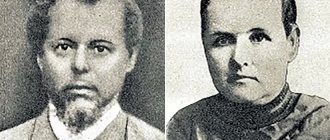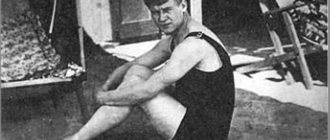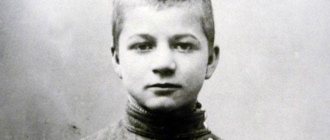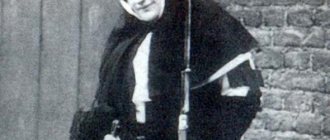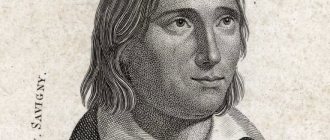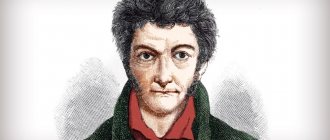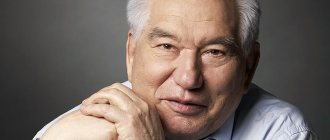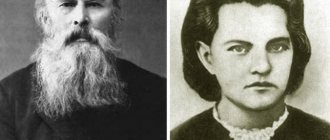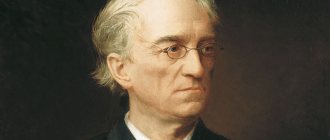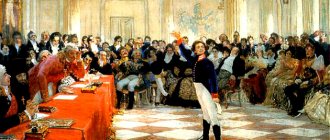Nikolai Chernyshevsky - Russian materialist philosopher, democratic revolutionary, encyclopedist, theorist of critical utopian socialism, scientist, literary critic, publicist and writer.
His greatest popularity was brought to him by the work “What is to be done?”, which makes the reader think about the global issues of life.
Chernyshevsky’s biography contains many interesting facts, and his life itself is filled with many fascinating events, which we will tell you about.
So, here is a short biography of Nikolai Chernyshevsky .
Brief biography of Chernyshevsky
Nikolai Gavrilovich Chernyshevsky was born on July 12, 1828 in Saratov. He grew up in the family of a simple priest, Gabriel Ivanovich, and therefore was familiar with the sacred books from an early age.
Until the age of 14, Nikolai was taught various sciences by his father, who was a competent, wise and comprehensively developed person. It is interesting that Chernyshevsky liked literature since childhood (see interesting facts about literature).
He devoted all his free time to reading books, as a result of which many adults were surprised at his colossal erudition and deep reasoning.
At the age of 15, Chernyshevsky entered the Saratov Theological Seminary. He received high grades in all subjects and was much more developed than all his fellow students.
However, after 3 years, he decided to leave the seminary and enter St. Petersburg University to study at the Faculty of Philosophy.
Nikolai Chernyshevsky in his youth
During this period of biography, serious changes occurred in the worldview of Nikolai Chernyshevsky. He became interested in revolutionary ideas and also became a supporter of democracy, socialism and materialism.
It is worth noting that the student was greatly influenced by members of Irinarch Vvedensky’s circle.
Personal life
Nikolai Chernyshevsky was married only once. His chosen one was the daughter of a Saratov doctor, Olga Vasilyeva. She was a very beautiful, energetic, brave and cheerful girl who took undisguised pleasure from the attention of her many fans. Offering her his hand and heart, Chernyshevsky most clearly outlined to her his views on family life. Being a staunch supporter of the emancipation of women, he, like the hippies of the 20th century, believed that a marital union does not give a man the right to limit the right of his chosen one to have love relationships with other men. He considered it his duty to create decent material conditions for his wife. Before his arrest, he earned good money from his articles in the press, and the lion's share of the income from fees went to her expenses. The Chernyshevskys had three sons: Alexander, Victor and Mikhail.
Teacher and journalist
Soon Nikolai Gavrilovich began writing his first works. In 1850, he successfully graduated from the university, after which he began working as a teacher.
After 3 years, he goes to St. Petersburg, where he gets a job as a teacher in the Second Cadet Corps.
At the same time, Chernyshevsky begins to publish in several publications. Later he gets a job in the editorial department of the Sovremennik magazine.
Work at Sovremennik
During this period of his biography, Nikolai Chernyshevsky met famous writers Dobrolyubov and Nekrasov, who, like him, were interested in revolutionary ideas.
The literary activity of the aspiring writer began to attract the attention of the current government. Officials and censors were afraid that he could cause unrest among the people with his revolutionary speeches.
Despite this, after some time Nikolai Chernyshevsky became a master of Russian literature.
Work at Sovremennik
Nikolai Chernyshevsky, whose biography was already known in the literary circles of the capital, became closest to Dobrolyubov and Nekrasov. These authors were passionate about revolutionary ideas, which they wanted to express in Sovremennik.
A few years earlier, civil riots took place throughout Europe, which echoed throughout Russia. For example, in Paris, Louis Philippe was overthrown by the bourgeoisie. And in Austria, the nationalist movement of the Hungarians was suppressed only after Nicholas I came to the rescue of the emperor, who sent several regiments to Budapest. The Tsar, whose reign began with the suppression of the Decembrist uprising, was afraid of revolutions and increased censorship in Russia.
This caused concern among liberals in Sovremennik. They (Ivan Turgenev, Vasily Botkin, Alexander Druzhinin and others) did not want the journal to radicalize.
Chernyshevsky's activities increasingly attracted the attention of the state and officials responsible for censorship. A striking event was the public defense of his dissertation on art, at which the writer gave a revolutionary speech. As a sign of protest, the Minister of Education Abraham Norov did not allow the prize to be awarded to Nikolai Gavrilovich. Only after he was replaced in this position by the more liberal Evgraf Kovalevsky, the writer became a master of Russian literature.
Chernyshevsky's views
At a young age, the writer studied various sacred books with interest and believed in God, but after he became acquainted with the works of French and German materialists, he began to actively criticize religion and the bourgeoisie.
Nikolai Chernyshevsky was an ardent opponent of serfdom.
In his articles, he called on the authorities to give people freedom. He compared the difficult life of the Russian people with black slaves in America.
The writer sincerely believed that a few decades after the liberation of the peasants, socialism would finally come to the state, in which all people would be equal.
It is worth noting that many of his ideas were far from reality and were rather utopian.
"Land and Freedom"
Over the course of many years of his biography, Nikolai Chernyshevsky propagated the ideas of the revolution, as a result of which he became the ideological inspirer of the revolutionary movement “Land and Freedom”.
Soon he entered into correspondence with Alexander Herzen, who had to emigrate abroad due to pressure from the authorities.
The association “Land and Freedom” was gaining increasing popularity. It included writers, military personnel, cultural figures and all those who sought political and social change.
Representatives of this movement constantly criticized the tsarist government and tried to convey their ideas to the common people. However, despite this, they did not find much response among the peasants.
Nikolai Chernyshevsky: father of Russian revolutionary thought
Chernyshevsky was born in 1828 into the family of a Saratov clergyman. The father of the future publicist came from serfdom and understood how important it is for a person to be educated. That is why the head of the Chernyshevsky family took upon himself the responsibility of teaching the young man. Gabriel Ivanovich gave his son knowledge, making him a literate person. Nikolai also loved reading books since adolescence. Chernyshevsky himself once recalled this: “I became a bibliophage, a devourer of books, very early...”.
Having received a high-quality education at home, Chernyshevsky went to the Saratov Theological Seminary. While studying at this educational institution, Nikolai Gavrilovich did not forget about self-education. At a young age, he had already read the works of major German and Greek philosophers, learned several foreign languages, and mastered socio-economic works. The theories of the materialists and utopians of the 18th century, the leaders of the Great French Revolution of 1789, made a huge impression on the young man. Among Russian authors, Chernyshevsky also had his own favorite. He was the critic and publicist Vissarion Belinsky, who repeatedly spoke out against the absolute monarchy in his articles.
Chernyshevsky in 1859. (wikipedia.org)
Successfully demonstrating himself in classes at the Saratov Theological Seminary, young Chernyshevsky established himself as the best student among his peers. Teachers noted that the young man was developed beyond his years, he excelled in all disciplines. Outstanding intellectual abilities helped Chernyshevsky in 1846 to enter the historical and philological department of the Faculty of Philosophy of St. Petersburg University.
During his student years, Nikolai Gavrilovich, having already become familiar with the works of Belinsky, continued to form his revolutionary views. Chernyshevsky was greatly influenced by the political events of those years that occurred in European countries. In 1848 - 1849, revolutions took place in several European countries, and all of them went down in history as the “Spring of Nations.” The young man at that moment empathized with the rebels.
Thanks to his university friend Mikhail Mikhailov, Chernyshevsky met an underground circle of Petrashevites, which included the young writer Fyodor Dostoevsky. Members of the circle were soon arrested for reading and distributing Belinsky’s letter to Nikolai Gogol, banned on the territory of the Russian Empire, but Chernyshevsky, who was not part of Mikhail Petrashevsky’s organization, remained free. At this time, Chernyshevsky became a member of another circle: a student of the Faculty of Philosophy began attending meetings of the society of one of the first Russian nihilists, Irinarch Vvedensky. At meetings, young people often discussed the need to abolish serfdom, provide Russian society with freedom of speech and limit the sole power of the monarch.
Monument to Chernyshevsky in Saratov. (wikipedia.org)
Chernyshevsky graduated from the university in 1850. By the end of his studies, Nikolai Gavrilovich became a convinced revolutionary. When Chernyshevsky was assigned to the Saratov gymnasium so that a young teacher could teach teenagers, the future publicist took advantage of this assignment to promote anti-monarchist ideas. “I have such a way of thinking that I should expect from minute to minute that the gendarmes will appear... I do things here that smell like hard labor - I say such things in class,” Chernyshevsky said about his activities at the Saratov gymnasium.
Having married Olga Vasilyeva in 1853, Chernyshevsky left his native Saratov and returned to St. Petersburg. The reputation of a freethinker, which Chernyshevsky gained due to the ideas he promoted in the gymnasium, did not prevent the young specialist from receiving a prestigious place in the Second Cadet Corps. Chernyshevsky continued to teach there, but soon, having quarreled with an influential officer, the revolutionary was forced to resign.
Portrait of Chernyshevsky. (vilianov.com)
Dismissal from the Second Cadet Corps served as the start for Chernyshevsky’s journalistic activities. Nikolai Gavrilovich was drawn to writing during his years of study at St. Petersburg University. At the end of the 40s of the 19th century, Chernyshevsky created several unfinished works of art. Reading various philosophers formed the young Chernyshevsky’s own system of worldview. It can be assumed that even in his student years, the future author of the novel “What is to be done?” there was a desire to transfer my thoughts and views onto paper.
Chernyshevsky began his journalistic career with the publication of small articles in such printed publications as St. Petersburg Vedomosti and Otechestvennye zapiski. Very soon, the young publicist was noticed by the poet and head of the Sovremennik magazine Nikolai Nekrasov, and Chernyshevsky began working in his publishing house.
Thanks to his journalistic activity and charisma, Chernyshevsky soon retrained from a promising author of articles to the second head of the publication, becoming on a par with Nekrasov.
After the death of Nicholas I in 1855, Alexander II ascended the Russian throne, which was marked by the granting of freedom of speech to newspapers and magazines. In this regard, Chernyshevsky, taking advantage of his authority in Sovremennik, quickly began to dictate his publishing policy: the magazine now had a pronounced revolutionary character, which is why many regular authors left the publication. For example, the writer and convinced liberal Westerner Ivan Turgenev, a supporter of gradual reforms in the Russian Empire, did not accept such radical changes within the policy of Sovremennik and refused to publish his works in this magazine.
It was also Chernyshevsky who helped Nikolai Dobrolyubov, who published reviews of new book releases in the magazine, to realize his potential. Later, Chernyshevsky appointed Dobrolyubov as head of the criticism department at Sovremennik.
Chernyshevsky's revolutionary activities were not limited to propaganda in Sovremennik. Since 1858, Nikolai Gavrilovich began editing the publication “Military Collection” - a monthly magazine whose main audience was officers.
After the abolition of serfdom in 1861, Chernyshevsky became the ideological inspirer of the revolutionary group “Land and Freedom,” which did not agree with the conditions under which Emperor Alexander II freed the peasants. On suspicion of connections with revolutionary emigration, Chernyshevsky was imprisoned in the Peter and Paul Fortress. Chernyshevsky was dubbed “enemy number one of the Russian Empire,” and an investigation was conducted against him for more than a year. During this time, Nikolai Gavrilovich wrote the novel “What is to be done?”, published in Sovremennik a few years later.
At the beginning of 1864, Chernyshevsky was found guilty “of taking measures to overthrow the existing order of government.” The revolutionary was sentenced to 14 years of hard labor, but Emperor Alexander II cut this term in half. After the ritual of civil execution in the capital of the Russian Empire, Chernyshevsky was exiled to Siberia, where, despite the personal intervention of the tsar, the publicist spent almost 20 years.
During his stay in exile, Nikolai Gavrilovich continued to engage in creativity. He wrote the novel "Prologue" and several unfinished stories.
Supporters of revolutionary ideas, for whom Chernyshevsky was a role model, were waiting for the publicist to return from Siberia. It is known that the revolutionaries even tried twice to organize Chernyshevsky’s escape from prison. However, both attempts failed, and their organizers were arrested.
In 1883, Chernyshevsky was released. The publicist settled in Astrakhan, and later moved to his native Saratov.
Chernyshevsky died in 1889, having become an ideologist for several generations of Russian revolutionaries. The journalistic heritage of the author of the novel “What is to be done?” Georgy Plekhanov and Vladimir Lenin praised it highly.
Sentence
Initially, Nikolai Chernyshevsky was sentenced to eternal exile, but later Emperor Alexander 2 (see interesting facts about Alexander 2) reduced the sentence to 7 years.
The years spent in hard labor seriously undermined the health of the disgraced writer. Despite all the difficulties that he had to endure, he was able to withstand all the trials.
Once free, Chernyshevsky lived in small towns until the end of his days. In recent years, he lived in Astrakhan, and only on the eve of his death was he allowed to return to his native Saratov.
Arrest
Over time, Chernyshevsky’s biography, in short, became of interest to secret investigation agents. On business with Kolokol, he even went to see Herzen in London, which, of course, only attracted more attention to him. From September 1861, the writer found himself under secret surveillance. He was suspected of provocations against the authorities.
In June 1862, Chernyshevsky was arrested. Even before this event, clouds began to gather around him. In May, the Sovremennik magazine was closed. The writer was accused of drafting a proclamation defaming the government, which ended up in the hands of provocateurs. The police also managed to intercept Herzen’s letter, where the emigrant proposed publishing the closed Sovremennik again, only this time in London.
Death and meaning
On October 11, 1889, N. G. Chernyshevsky died in his hometown. The writer’s biography became the subject of imitation by many followers and supporters.
Soviet ideology put him on a par with the figures of the 19th century who were the harbingers of the revolution. The novel “What to do?” became a mandatory part of the school curriculum. In modern literature lessons, this topic is also studied, only fewer hours are allocated to it.
In Russian journalism and publicism there is a separate list of the founders of these areas. It included Herzen, Belinsky and Chernyshevsky. Biography, a summary of his books, as well as his influence on social thought - all these questions are being studied by writers today.
